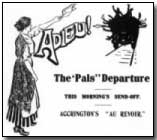Encyclopedia - Pals' Battalions
 A phenomenon of the First
World War, Britain's so-called Pals' Battalions arose purely from the
country's unsatiated requirement for men to despatch to the various British
battlefronts around the globe.
A phenomenon of the First
World War, Britain's so-called Pals' Battalions arose purely from the
country's unsatiated requirement for men to despatch to the various British
battlefronts around the globe.
Britain was alone among the major European powers in 1914 in not having in place - or rapidly adopting - a system of conscription. Not only was popular sentiment against mandatory military service, mainstream political opinion was yet to conclude the inadequacy of a purely voluntary system of recruitment (advocated by leading figures such as Foreign Secretary Sir Edward Grey).
Various methods were adopted as a means of encouraging men to enlist with the armed services during the war's early years, including the 1915 Derby Scheme; while successful in their own limited way none could ensure a constant supply of human material. Consequently conscription was finally embraced in January 1916 (and was progressively extended until, in April 1918, men aged from 18 to 51 were liable to be called up).
Before conscription however; before the Derby Scheme; indeed in the first weeks of the war in August 1914 Lord Derby encouraged the notion (initially suggested by Sir Henry Rawlinson) of encouraging whole towns and villages to sign up with the promise that they should also serve together: in short, sanctioning the establishment of Pals' (or Chums') Battalions.
Wildly popular from the outset - and boosted by a highly publicised poster campaign led by the War Minister (and popular military hero) Lord Kitchener - men flocked to recruitment centres to enlist in whole groups. The promise that they should serve with their friends and relatives was invariably honoured. Those who joined the British Army in such circumstances often set off with promises of guaranteed post-war employment ringing in their ears.
Such a policy may have ensured the initial success of the recruitment campaign - some three million men volunteered for service in the first two years of the war, with 50 towns boasting Pals' Battalions by September 1914 alone - but its drawbacks were brought starkly home with the first real test of the Kitchener (K) or 'New Armies' at the July 1916 Battle of the Somme.
On the first day of the battle many men who signed up alongside one another also perished together. For example the 11th Battalion (East Lancashire Regiment) suffered 585 casualties on 1 July 1916 from 700 who started that day. Accordingly whole villages suffered from the localised nature of recruitment.
Examples of Pals' Battalions included three battalions raised from Glasgow alone (the 15th, 16th and 17th Highland Light Infantry).
A 'Gearsman' was a tank crew member responsible for managing the gears.
- Did you know?
